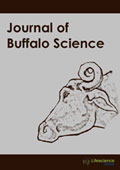jbs
Abstract : Haematopinus Infestations and Mycoplasma Infections of Water Buffalo (Bubalus bubalis) Herds in National Parks of Hungary
|
|
Abstract: The biology, epidemiology and pathology of sucking louse infestation and Mycoplasma infection of water buffalo (Bubalus bubalis) herds in Hungarian national parks were studied between 19 December 2011 and 4 May 2012. A total of 333 water buffaloes were examined in buffalo stocks of the Balaton Uplands, Fertő-Hanság and Kiskunság National Parks. The objective was to determine the prevalence and rate of sucking louse infestation and mycoplasma infection among water buffaloes. Always an area of identical size (2 cm2) was examined on the right or left side of the middle part of the animals’ neck. A total of 3106 eggs, 10 nymphs and 105 adults of the sucking louse Haematopinus tuberculatus were identified with the help of a Conrad USB microscopic camera and a Wild-Leitz-Leica M420 photomacroscope. The data were evaluated using the Quantitative Parasitology software QP 3.0. The prevalence of mycoplasmas was determined in 20 randomly selected buffaloes of two national parks with the help of sterile nasal and vaginal transport swabs (Sarstedt). All of the 10 nasal swabs collected from buffaloes in the Balaton Uplands National Park contained Mycoplasma bovirhinis and three swab samples yielded M. bovis as well. Mycoplasma bovirhinis was cultured from 8 out of 10 swabs taken from the vagina, and three vaginal samples also yielded M. bovis. Similar results were obtained by testing samples collected from buffaloes in the Kiskunság National Park (Mórahalom). All ten nasal swab samples yielded M. bovirhinis. From two samples a mixture of M. bovirhinis and M. bovis was cultured. Nine out of the 10 vaginal swabs yielded M. bovirhinis while two showed a combined infection by M. bovis and M. bovirhinis. Keywords: Haematopinus, sucking louse, Mycoplasma, infection, water buffalo, Hungary.Download Full Article |
Abstract : Effects of Enteral Fluid Therapy in Continuous Flow Administered by Nasogastric Tube in Buffalo Calves
|
|
Abstract: To investigate the employment of enteral fluid therapy in continuous flow administered by a nasogastric tube in buffalo calves; toassesstheeffectsof a hypotonic and an isotonic electrolyte solutionon: vital functions, blood count and serum andurinary biochemistry profile of buffalo calves. Seven buffalo calves, clinically healthy, were submitted to two treatments. The solutions were administered in continuous flow through a nasogastric tube at a dose of 15 mL/kg/hr for 12 hours. The serum biochemistry profile showed an increase in chloride concentration, decrease in serumurea and osmolarity. In urine, anincrease in sodium and chloride concentrations and a decrease in calcium, creatinine and urea were observed. Enteral fluid therapy in continuous flow proved to beeasy to use and effective in maintaining volemia and concentration of electrolytes in buffalo calves. Keywords: Dextrose, maltodextrine, electrolytes, biochemestry, hydration.Download Full Article |
Abstract : Omphalitis Leading to Urachitis and Acute Vascular Changes in a Buffalo Calf: An Insight into Macro and Microscopic Pathologic Changes
|
|
Abstract: Omphalitis in domestic animals being considered as commonest ailment after birth, are in general, poorly reported for its uneventful recovery. Several previously reported cases endeavoured to highlight involvement of pathogenic organism in progression of the condition with little elaboration to pathologic changes occurred. Moreover, description of omphalitis in buffalo calf was never been attempted. Therefore this report intends to elaborate the pathology noted around umbilical zone in a buffalo calf possibly arisen to infectious etiology with special reference to complicated involvement of urachus, eventual haemoperitoneum and striking acute vascular changes of multi-systemic organs. Intriguingly, this report also attempted to review few recent cases of omphalitis seen in different animals along with their paramount etiologic causes. Keywords: Omphalitis, Urachitis, Pathology, Buffalo calf.Download Full Article |
Abstract : The Domestic (Water) Buffalo in Africa: New and Unusual Records
|
|
Abstract: The domestic (water) buffalo is not indigenous to Africa. Some buffalo may have been taken to what is now Tunisia in Roman times about 2000 years ago. The species arrived in Egypt from Mesopotamia some 1200 years past and there were attempted introductions to the east coast of Africa by the Portuguese from India in the sixteenth century. The missionary-explorer David Livingstone took four buffalo from India to what is now southern Tanzania in 1866. In the twentieth century, European powers introduced buffalo to many of their African colonies. In addition to Egypt and Tunisia on the Mediterranean coast of north Africa buffalo have been introduced to fourteen subSaharan countries. Information on these introductions is sparse and is obviously incomplete. With the exceptions of Tanzania, where there have been buffalo for 90 years, and Mozambique, where there is documented presence over about 50 years, buffalo have been present for very short periods. They have disappeared without trace in some countries and have been culled in others due to adaptation or disease problems. Suitable ecological niches for buffalo exist in many African countries. Too few animals, failure to provide sufficient public financial resources and lack of private sector interest are among the reasons for the buffalo’s failure to contribute to African livestock production. Keywords: Introductions, exotic animals, domestic livestock, animal disease, adaptation.Download Full Article |






















